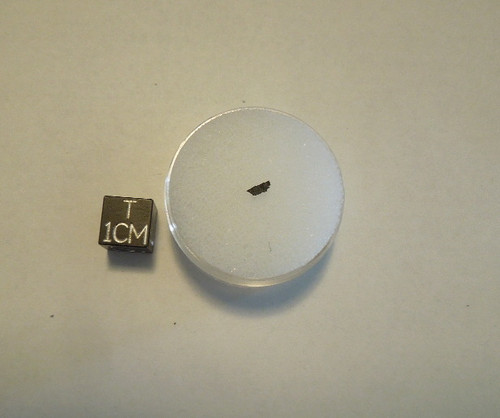NWA 1232 was brought out of Morocco in May 2001. It was a single stone that revealed two different lithologies when cut. Both lithologies are carbonaceous (CO3), but they have different colors - black and lighter grey. The mean chondrule sizes and distribution vary between the lithologies. This is one of the earliest examples of a CO3 meteorite available to collectors at the time, and the price for this meteorite was almost $1k per gram. The market has changed since then, but it's low TKW and availability make it a rarity. This is the only non-crumb specimen that I have in stock.
The specimen being offered here is a small part slice that shows a wealth of tiny chondrules for it's size. One side is polished. It weighs approx. .105g (105mg).
Refer to the photo. The black centimeter cube is shown for scale and is not included. You are purchasing the specimen shown. Your purchase will include a labeled gemjar for safe storage.
From the Meteoritical Bulletin entry on NWA 1232 :
Northwest Africa 1232
Morocco
Find: May 2001
Carbonaceous chondrite (CO3)
History: In May 2001 B. Fecay and C. Bidaut purchased the stone in Zagora, Morocco.
Physical characteristics: A single piece weighing 1900 g. Approximately 40 % of its surface is covered by fusion crust.
Petrography: (M. Kiriishi and K. Tomeoka, UKobe) Two different lithologies separated by a sharp boundary; lithology A is dark gray, lithology B is light gray. Both lithologies contain well defined chondrules set in a fine-grained matrix. Lithology A consists of ~ 53% chondrules, ~ 2% CAIs, and ~ 7% AOIs (all vol%), whereas lithology B consists of ~ 50% chondrules, ~ 3% CAIs, and ~ 5% AOIs (all vol%). Chondrules in lithology A range in apparent diameter from 50-510 mm with an average of ~ 128 mm, whereas those in lithology B range from 50-500 mm (average ~ 147 mm).






